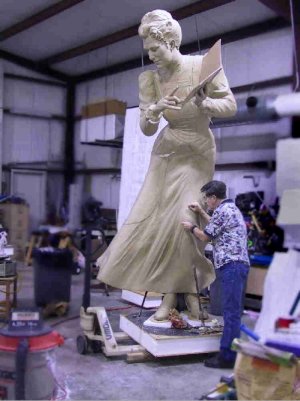
Artesia MainStreet, Inc. announced that final approvals have been received to sculptor Robert Summers of Glen Rose, Texas, for a bronze statue of former resident, Sallie Chisum.
Also known as Sallie Chisum Robert, she is generally recognized as “Artesia’s First Citizen” and has been called “the First Lady of Artesia” by Artesia Historical Museum and Art Center Director Nancy Dunn.
Sallie — niece of the historically noted cattle baron John Chisum — became known in the years before her move to the Artesia area as the “Queen of the Jinglebob” during the time she took up residence at the famous Long House, her uncle’s ranch headquarters for the spread on which he quartered up to 80,000 head of cattle.
Sallie married Chisum’s bookkeeper, William Robert, and they had two sons. The couple eventually divorced, and Mr. Robert arranged schooling for the boys in Germany.
Several years after the death of (her uncle) the cattleman, Sallie moved to Chisum’s Spring Line Camp located in present-day Artesia, where she built an adobe home and developed the property. Sallie’s home was swept away by one of Eagle Draw’s gully-washers but, undaunted, Sallie rebuilt near the same spot, where she lived with her father until his passing. She built her third and final home in Artesia in 1908.
Today the home is listed on the National Register for Historical Places and is headquarters for Grammy’s House, a shelter for victims of domestic violence.
Sallie married a second time to promoted and developer, Baldwin Stegman. A post office was established in one of their buildings and Sallie became the town’s first postmaster. Soon one of their structures became known as the Stegman Hotel on Robert Heights in the area that consisted of two buildings and a general store, and became known as the town of Stegman.
After the couple’s divorce, Sallie became recognized by travelers and locals as a very hospitable and serving woman. She remained in the growing town for years, having retaken the name of her first husband although they were not reunited.
A resourceful pioneer, Sallie progressed in city affairs as a successful businesswoman. Early citizens remember her as a warmhearted and helpful woman who loved children and was well liked by her neighbors who often called upon her in their times of need.
Sallie was born in 1857 and died in 1934 at the age of 77. She lived in Artesia for nearly 30 years, until 1919 when she moved to Roswell after a brief stay in California.
Artesia MainStreet recently welcomed the arrival of an 18-inch bronze maquette that will be used in fundraising efforts to fund a more than 10-foot-tall monument to Sallie Chisum that will be placed in Artesia’s newly renovated downtown district.
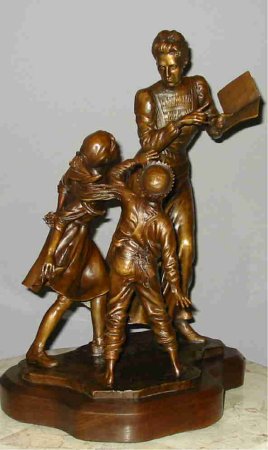
Funding for the sculpture will be covered by contributions from private citizens and businesses. Artesia MainStreet continues to seek donations. If you are interested in contributing to the fund, or learning more about Sallie Chisum or the artist, please call Artesia MainStreet manager, Hayley Klein at 505-746-1117.
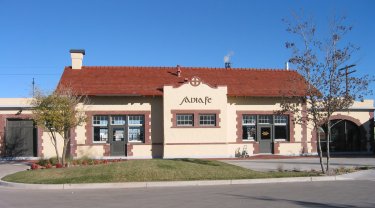
One of Artesia’s many success stories in preservation is the recent restoration of our Santa Fe Railway depot. It’s taken several groups working together to make it happen, but we did it!
There was a lot of railroad traffic up and down the lower Pecos Valley in 1912, and Artesia decided it was time to improve traveler accommodations by replacing its 15-year-old wooden frame depot building with something grander. The new-and-improved passenger depot included high ceilings for coolness and an outdoor as well as indoor waiting area for passengers. Brick walkways were also installed for those wanting to stretch their legs.
Passenger service was discontinued in 1967, and the depot was closed in 1988. It sat vacant for years after that, remaining untouchable for any other use due to railroad restrictions, until Artesia’s First Street project and constructing a new building alongside the depot was a solution that worked for everyone. The Chamber mounted a major fundraising campaign of their own, and today the 1912 Santa Fe Railway depot serves as a Visitors’ Center alongside Artesia’s new Chamber of Commerce Building.
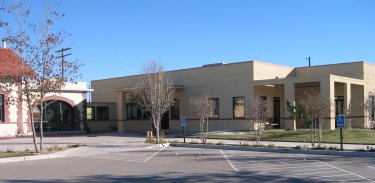
In its new incarnation, the depot/Visitors’ Center features early railroad photos from Artesia as well as a wonderful dairy industry museum/display area. Also currently on display are several Painted Ponies. All sorts of basic visitor and travel information is available, and cheese made by our local dairies can be purchased there.
The next time you’re passing through Eddy County, remember to visit our old/new depot/Visitors’ Center — you’ll be glad you did!
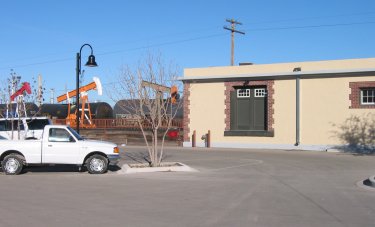
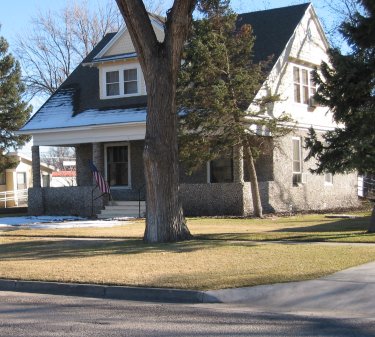
Typical remarks from a typical day at the Artesia Historical Museum and Art Center:
“Wow! I’ve lived here all my life and this is my first time to visit here. I didn’t know you had all this neat stuff!” (Yep, we sure do — and we rotate the exhibits periodically so that there’s always something new to see.)
“We’ve been driving for hours; we’re so glad you have something for the kids to do!” (We have a huge yard to run amok in, with Native American grinding stones and antique tractors to explore plus a Children’s Room inside with clothes and hats to try on.)
“How many cobblestones are there on the outside of the house?” (Eleventy billion.)
“Are there ghosts in the house?” (Don’t think so; we’d have met them by now.)
“Do you live here?” (Just feels like it.)
As you may have gathered by the above quotes, the Artesia Historical Museum and Art Center has something to catch the interest of nearly everyone. The Museum opened in 1971, in the historic Moore-Ward house (built in 1904) and our exhibits focus on aspects of local and area history. The house’s exterior is made up of Penasco River rocks set in concrete, creating the “cobblestone” look that has intrigued everyone. Before you ask, it IS original to the house and they took nearly two years to set in place.
Inside, permanent exhibits include a room of Native American artifacts, a 1920s-era kitchen, a farm and ranch living room, and an oil and mineral room. Next door to the Museum is the Art Annex gallery (also in the old house), which features local art shows, traveling exhibits, temporary in-house exhibits and other shows. Some recent exhibits included the Artesia Quilt Guild display of works through August 2001; the 9th annual Russell Floore Memorial Art Show that ran from September 9 through October 15, 2001; and a display of turned wood bowls, canisters and other objects by Scott Burton of Eunice through January 2002.
Stop by and check us out. We’re at 505 West Richardson Avenue in Artesia. Our hours are Tuesdays through Fridays 9 a.m. to noon and 1 p.m. to 5 p.m. and Saturdays 1 p.m. to 5 p.m. We can be reached at 505-748-2390 or emailed at ahmac@pvtnetworks.net
For more information and photos of Artesia, its MainStreet and its Depot/Visitors’ Center, click on the Archives button and open the Industry Page of the 3rd Issue for the article: Artesia, the Little City that Could, also known as Artesia, Where Water and Oil do Mix.

there was a boy called Billy in the Territory of New Mexico.
Now Billy wasn’t his name back at the beginning of his life;
they say that it was Henry and he was born to one then not a wife.
His mama’s name was Catherine, and he had a brother named Joe.
His mama’s last name was McCarty, so too was his and Joe’s.
Most historians say Henry McCarty was born without a dad
in New York to an Irish lassie and the way they lived was sad.
Our Henry had arrived there on his birthing day
in an Irish slum in 1859, so some historians say.
Still, little is known about him, back in his early years
except knowing how to feed him was his mama’s greatest fear.
They lived a while in Kansas, made a stopover in Denver too;
why they landed in New Mexico, historians have no clue.
What was it drove them onward? Why did they end up here?
Were they searching for a better life, or was it plain despair?
Some say their lives got better before arriving here
’cause Catherine took a partner to share her load with her.
At any rate, they came here, to live in this wild place,
Catherine, Joe, Henry — and Will, a guy historians trace
to Kansas on the plains, a place called Wichita.
Even then, young Henry called William Pa.
So, long before they got here, they’d ambled other places,
frustrating historians by leaving few traces.
Census, courts and archives, even churches cast
few if any clues upon our mysterious Billy’s past.
One thing they know for certain (at least they think they do) —
the Santa Fe Book of Marriages holds their first recorded clue.
The widow, Catherine McCarty, in Santa Fe, New Mexico,
stood with Henry and Josie (what they called her boy Joe) —
as she said her wedding vows, the boys stood up with them
at First Presbyterian with her and William Henry Antrim.
That was the first known record establishing when he —
our Bonney lad — was in New Mexico: that was in 1873.
Like his mom, Henry McCarty right then changed his name
to Antrim. “William or Will like my new pa, if it’s all the same.”
Confusing historians, he was Henry McCarty just the same,
but William Henry Antrim right then became his name.
In Santa Fe the Antrims’ days of wandering still weren’t done;
they traveled to Silver City to bask in its arid sun.
It was there the young William Antrim, called Will,
took yet another name. “Just call me The Kid or Bill.”
Then his beloved mother died of consumption or T.B.
It broke the heart of Billy; a boy he’d no longer be,
for there the young lad, Billy, began his criminality.
On a lark he stole some clothes from a Chinaman’s laundry.
It was only for the fun of it, but the sheriff did not laugh.
The Kid was thrown in jail but his lock-up did not last.
The Kid determined a little space with just a cot and pail
was not to be the end of this, our cunning Billy’s tale.
He conned the sheriff’s deputy, and knew well how to shimmy
so he made quick his escape right up that red brick chimney.
That proved to him and all the rest his wiles and slippery ways,
and that was just the beginning of his desperado days.
(Now what could you expect, since Billy’s home life wasn’t sound?
And his step-dad didn’t care much to have the boy around?)
He was a homely kid, buck-teeth and prominent ears,
so he relied upon his ways of charm and lack of boyish fears
to win him loyal friendships, cause girls to think him cute.
Still, his winning way was because … boy, could he shoot!
So … who was our Henry McCarty, William H. Bonney, “The Kid?”
Where did he come from, who was his ma, why did he do what he did?
Of his latter years (alas, so few), we know his story well
for many, including Pat Garrett, his stories loved to tell.
His antics, shoot-outs, hot pursuits are documented well
in books, in movies and in songs, stretched out so they would sell.
And sell they did, even in England, for folks there love a tale —
of strife, romance and intrigue as they quaff their brew and ale.
***
(To see earlier portions of this poem, click the Archives button and go to Byway pages of the previous issues.)
Pictured below is the Santiago Bonney Ditch as it appears today, 160 years after it was dug in northeast New Mexico by Englishman James Bonney in 1842 near his home and trading post along the Santa Fe Trail at a place then called La Junta, “the junction,” so-named because of the convergence of rivers.
In late summer of 1846, during their successful expedition in conquest of New Mexico and California for the U.S., Col. Stephen Watts Kearney and his Army of the West, and Col. Alexander W. Doniphan and his troops and caissons, camped at La Junta as guests of James Bonney, who supplied them his choicest beef. A few months later, Bonney was killed by Indians when he went in pursuit of them to retrieve his stolen horses. He went alone except for his young Indian guide, and took his wife’s fresh-baked tortillas for barter. That was a fatal mistake.
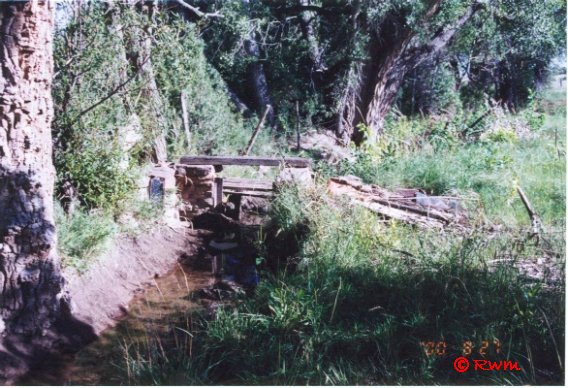
Santiago Bonney Ditch
The origins and genealogy of Billy “The Kid” Bonney and his early life remain a mystery. So too is the mystery of why he, in the latter portion of his short life, adopted the name Bonney. Most published historians think that: a.) He began life in New York as Henry McCarty; b.) He changed his name to William Henry Antrim to match his stepfather’s after his mother’s marriage in Santa Fe in 1873; and c.) He adopted the name William H. or Billy Bonney in the last years of his life. Historians don’t know from where he acquired or why he adopted the Bonney name. Serious historians admit that they are uncertain of his origins, but think he might have been born in a New York City Irish slum in 1859. Both the place and the date of his birth could be incorrect.
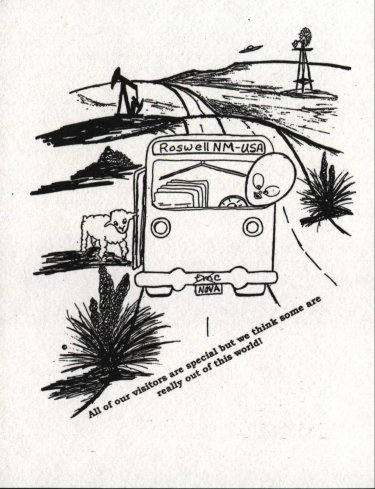
“All of our visitors are special, but we think some are really out of this world!”
 Roswell Web Magazine
Roswell Web Magazine